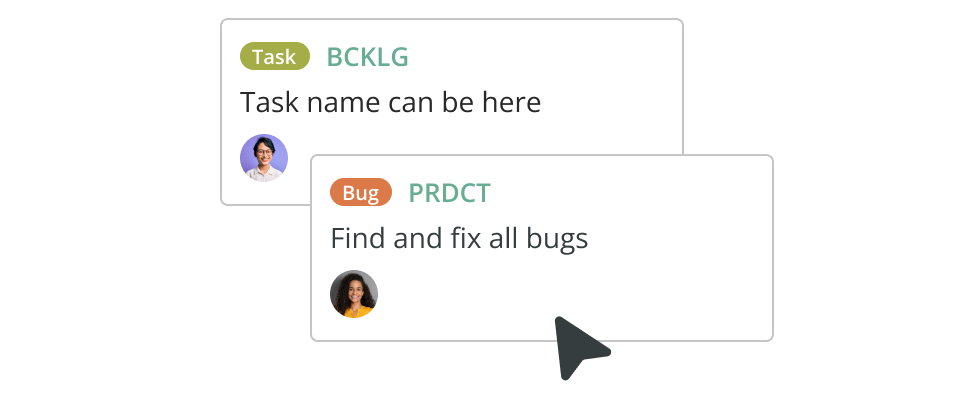Products don’t just appear and then die. Behind the scenes, there’s an army of developers, marketers, and creatives shaping both the thing itself and the market around it. It’ll come as no surprise, then, to learn that managing this process is central to success.
Product Lifecycle Management (or PLM for short) is a system for making this exciting but hectic process as smooth as possible. And if you’re in the product development business, it pays to know it inside out. In this article, we’ll take you through what it is, why it matters, and, most importantly, how to do it like a pro. Let’s go!
What is PLM?
PLM is exactly what it sounds like. It’s a system for managing a product as it moves through its ‘lifecycle’, from cradle to grave.
The 4 stages of the product lifecycle
The product life cycle is a framework for understanding how a product evolves from conception to retirement. It is typically divided into four key stages:
- Introduction: This is when the product is brand new. It’s launched into the market, and your marketing efforts focus on awareness and customer education. Sales (hopefully) start to grow.
- Growth: The product gains traction, sales go up, and you get a bigger customer base. Companies often adjust their marketing campaigns to focus on increasing competition and potentially evolving their products based on feedback.
- Maturity: At this juncture, the product reaches peak market penetration. Sales growth plateaus as the market reaches saturation point. Businesses might modify their offering, change their pricing, or do a big marketing push to reignite interest.
- Decline: Eventually, every product encounters a buying slowdown due to market saturation, technological advancements, or changing consumer preferences. At this stage, companies decide whether to rejuvenate the product through innovation or phase it out and focus resources on newer offerings.
PLM is a strategic way to coordinate people, processes, information, and business systems to make the product’s life cycle as efficient as possible. By combining all of the above in a structured way, PLM improves operations and fuels innovation. This makes it a must for companies that want to thrive in competitive markets.
What’s the difference between product lifecycle management and the product development lifecycle?
The difference lies in their focus and stages within a business context.
The product lifecycle is about how a product moves from introduction to decline, plus how each of these stages is managed. The product development lifecycle, on the other hand, is a subset of the overall product lifecycle.
The latter deals with the creation and launch of a product, focusing on the processes that take it from concept to market-ready. Think of it as a springboard that propels a product into the product lifecycle.
The benefits of PLM
Good PLM has a direct impact on a company’s success. Because it streamlines product development, it helps you launch products faster, which gives you a competitive edge.
It also improves collaboration across the departments by creating a centralized hub for all your products’ data. This means everyone can access the latest information, which, in turn, lowers errors and downtime.
Finally, PLM cuts costs by improving resource management and minimizing waste. It helps organizations spot inefficiencies and optimize processes, boosting product quality, innovation, and flexibility.
- Faster product launches
- Enhanced departmental collaboration
- Updated product information accessibility
- Reduced operational costs
- Improved resource management
- Easier compliance with industry standards
- Enhanced product quality
- Increased innovation potential; and
- Agile market response.
The key phases of the PLM system
These all depend on the complexity of the product and the industry it’s in. Here’s a straightforward breakdown of an approach that software providers and manufacturers often use.
1. Concept/idea generation
- Objective: Identify market needs, brainstorm ideas, and outline initial concepts for a new product.
- Activities:
- Product research, including market research, to understand customer needs and gaps.
- Feasibility studies and early cost assessments.
- Initial conceptual designs and product features.
- Key deliverables: Product concepts, market requirements, feasibility reports.
2. Design and development
- Objective: Translate product concepts into detailed designs and engineering specifications.
- Activities:
- Product architecture design, CAD models, and simulations.
- Prototype creation and testing.
- Design reviews, refinement, and validation.
- Defining bill of materials (BOM) and supplier engagement.
- Key deliverables: Prototypes, engineering drawings (including wireframes), validated design specs.
3. Manufacturing and production
- Objective: Scale up for production, ensuring designs are manufacturable and cost-effective.
- Activities:
- Establishing production processes and workflow optimizations.
- Tooling and equipment setup.
- Pilot production runs for validation.
- Quality assurance and finalization of the production plan.
- Key deliverables: Manufacturing plans, production equipment setup, production-ready designs.
4. Market introduction (launch)
- Objective: Bring the product to market and drive adoption.
- Activities:
- Marketing and promo campaigns.
- Distribution channel setup.
- Launch events and customer education.
- Monitoring customer feedback and initial performance.
- Key deliverables: Marketing collateral, sales strategies, bringing the product to market.
5. Service and support
- Objective: Manage the product post-launch, providing customer support and improving customer satisfaction.
- Activities:
- Customer training and troubleshooting.
- Regular updates, maintenance, and service plans.
- Managing spare parts and after-sales services.
- Key deliverables: Service documentation, support systems, spare parts inventory.
6. End of life (retirement/disposal)
- Objective: Plan and manage the product’s phase-out or discontinuation.
- Activities:
- Communication with customers and stakeholders regarding discontinuation.
- Inventory clearance and phasing out manufacturing.
- Planning for recycling, disposal, or transitioning customers to new products.
- Key deliverables: End-of-life plan, customer communication, disposal/recycling documentation.
How to do PLM like a pro
Mastering Product Lifecycle Management (PLM) involves a blend of strategy, technical prowess, and continuous learning. Here’s how you get the most out of every phase of your product’s lifecycle.
Take a holistic approach
Look at the whole process as one integrated flow rather than focusing only on lone stages. Getting all departments involved — like design, engineering, marketing, and customer support — right from the beginning makes for smoother transitions throughout the lifecycle.
- Encourage collaboration across teams: Involve everyone in early discussions, from R&D to sales.
- Use shared tools: Make sure everyone is on the same page with centralized product management software, which helps teams access up-to-date product information easily.
Focus on the early planning stages
Getting things right in the concept and design phases can save time and money later on. A pro-level PLM approach puts a lot of emphasis on early planning and validation.
- Use iterative design: Test concepts quickly and often, refining designs based on early feedback. Digital simulations or digital twins can help test ideas without costly prototypes.
- Prototype early: Build rapid prototypes to validate your design and spot any issues before moving into expensive production.
Manage changes smoothly
Change management is crucial in PLM, especially when you need updates or revisions. The key is to stay ahead and handle them well without disrupting the workflow.
- Track versions carefully: Make sure all those design changes get documented, with strict version control in place so you can be sure everyone’s working on the latest design.
- Set up approval processes: You’ll want clear, automated approval processes to keep things moving smoothly.
Keep product data centralized and clean
Pros know poor data management equals confusion and mistakes. Keep product-related info — design files, specifications, test results — in one centralized place (your product management software, ideally) to make collaboration easier and cut down on errors.
- Centralize all product data: Store everything in a single, easily accessible platform like Backlog to avoid scattered or outdated files.
- Implement good data governance: Define who owns the data, who can access it, and how the team applies updates so your information is correct at all times.
Prioritize quality from the start
Quality should be a part of every phase of the product lifecycle, not just an afterthought. Adding quality management systems early means the product meets expectations, and expensive defects are kept to a minimum.
- Design with quality in mind: Think about product quality early in the design phase, ensuring that it’s easy to manufacture and use.
- Test continuously: Set up ongoing testing throughout development to catch issues early.
- Close the loop on quality: Use post-launch feedback to improve the product in future iterations.
Stay flexible in production
A pro-level PLM approach prioritizes agility. Being able to adjust to design changes or market demands quickly gives you a competitive edge.
- Keep production adaptable: Use flexible manufacturing techniques, like modular setups or 3D printing, to make quick changes if needed.
- Work closely with suppliers: Keep open lines of communication with suppliers to avoid delays. And make sure they can accommodate any changes.
Speed up time-to-market
Time is of the essence when you’re launching a new product into the world. To get it to market faster, you’ll need to avoid unnecessary delays.
- Work on components at the same time: Simultaneously develop different parts of the product to reduce waiting time.
- Eliminate waste: Apply lean principles, cutting out inefficiencies while ramping up the things that add value.
Extend the product lifecycle and think sustainably
Being a PLM pro means planning for sustainability. This means extending the product’s life where possible. It’s good for business, and also for the environment.
- Design with sustainability built in: Use eco-friendly materials and make designs that are energy-efficient and recyclable. Don’t chase a cheap buck and make products with a short lifetime. Consumers are increasingly green-minded and critical of unethical practices.
- Plan for end-of-life: Have a clear route for retiring products, including recycling and ways for customers to shift to newer versions.
10. Learn from every phase
A professional PLM approach is one that continuously improves. Collect feedback and data from each phase of the product lifecycle and use it to enhance future products.
- Monitor after launch: Track how your product performs post-launch, gathering customer feedback and service data metrics to shape future improvements.
- Apply lessons learned: After each phase, take time to analyze what worked and what didn’t, and make sure to apply those insights to your next project.
Use the right PLM software
Technology can be a game-changer for PLM. Professional-level PLM hinges on software that automates tasks, tracks every stage, and helps you make decisions based on data.
- Pick the best software for your needs: Choose a product management tool that integrates well with your existing systems. You’ll also want one that can grow with your business.
- Automate wherever possible: Automate routine tasks like approvals and version control. It’ll save you heaps of time, not to mention cut down on errors.
- Make decisions based on data: Use the analytics from your PLM software to spot trends and make informed product decisions.
To do PLM like a pro, you need to approach it with collaboration, smart tech usage, and a focus on continuous improvement. By integrating the right tools and best practices, you’ll streamline every stage of your product’s lifecycle, resulting in better products and smoother workflows.





